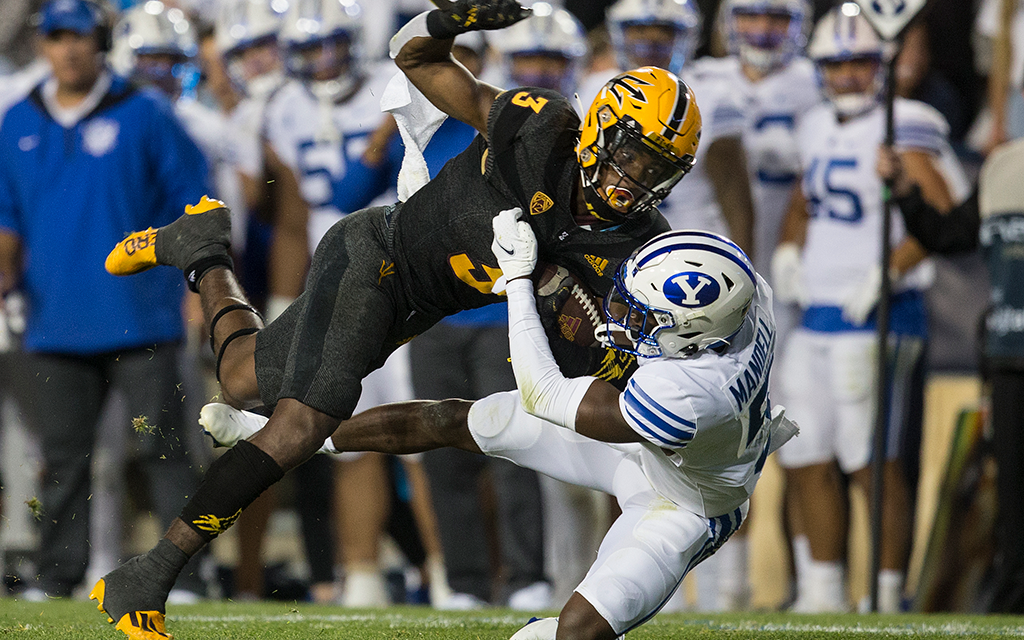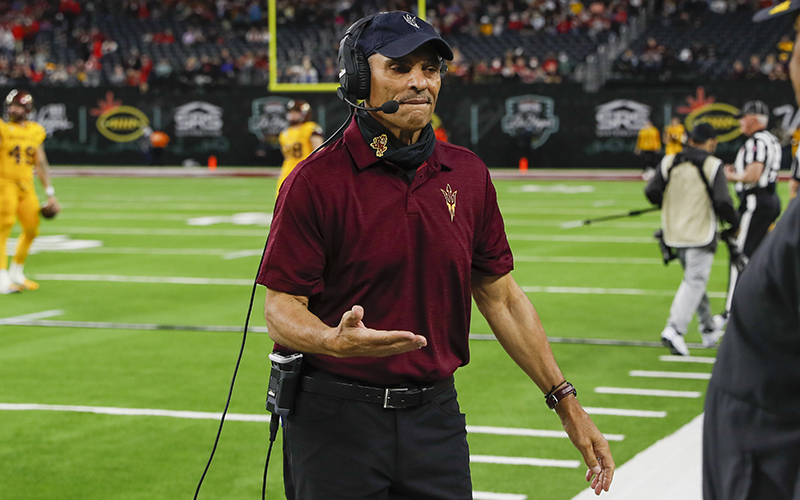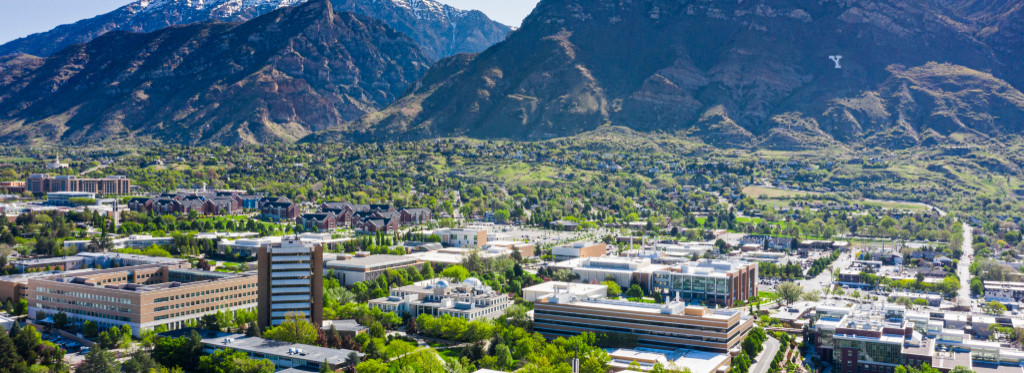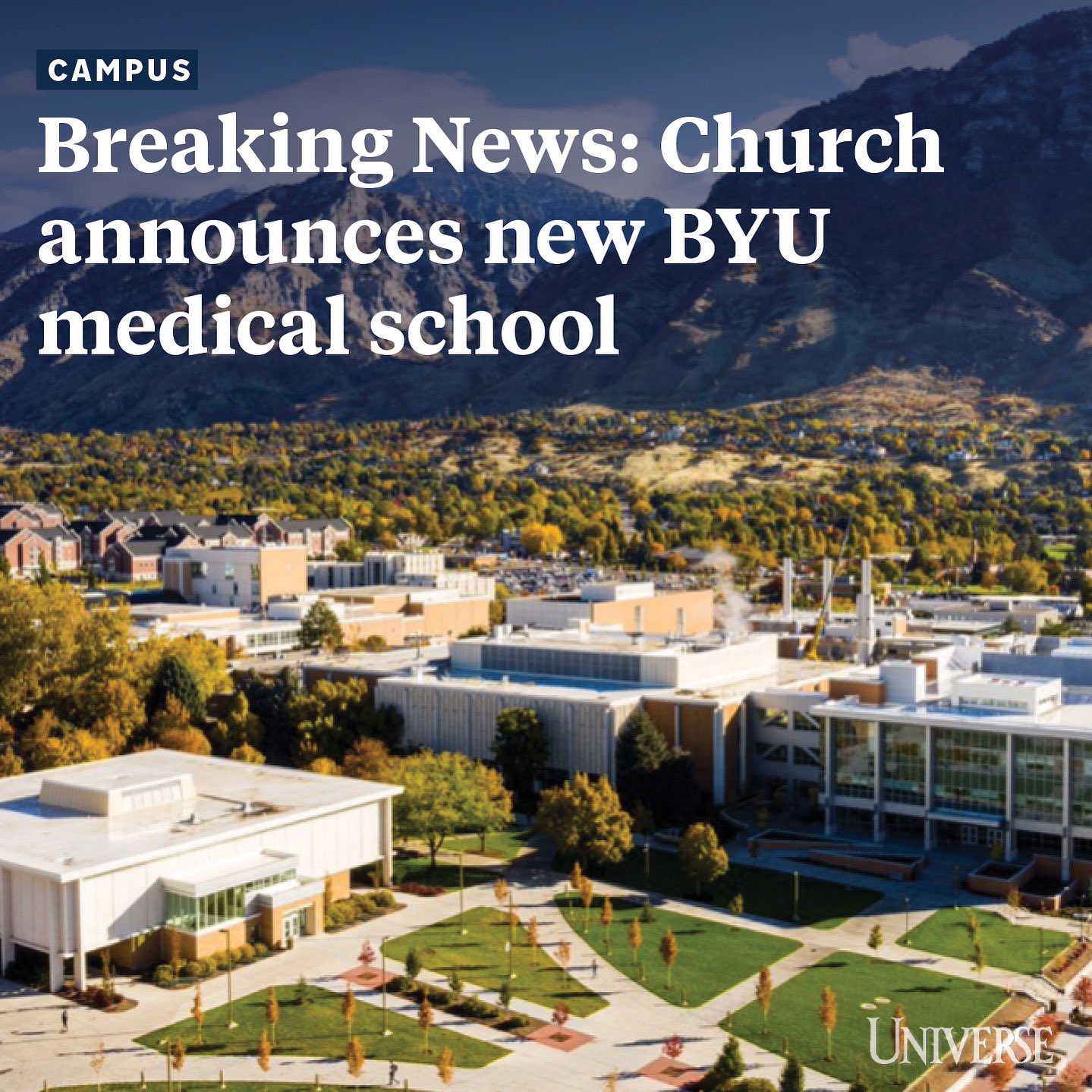Utah’s population nearly doubled from 1.72 million in 1990 to an estimated 3.41 million in 2023, according to U.S. Census Bureau population estimates, creating more need for health care professionals.
The announcement was made Monday in a statement from The Church of Jesus Christ of Latter-day Saints
Tad Walch covers religion with a focus on The Church of Jesus Christ of Latter-day Saints.
BYU is going to build a medical school.
The announcement was made Monday morning by The Church of Jesus Christ of Latter-day Saints, which sponsors BYU.
“The First Presidency is pleased to announce the decision now to create a medical school at BYU,” the church statement said.
“A major focus will be on international health issues affecting members of The Church of Jesus Christ of Latter-day Saints and the church’s worldwide humanitarian efforts.”
The announcement did not say where the school would be located, when it might open or how large its first class will be. Church leaders did say the BYU medical school would be focused on teaching, that it would draw students from around the world and that research would emphasize areas of strategic importance to the global church. . .
In 2023, 360 BYU graduates applied to medical schools.
In 2023, 360 BYU graduates applied to medical schools.
- Over 51% were accepted, well above the national average of 41.9%.
- The University of Utah medical school was the No. 1 school accepting BYU graduates, receiving 17, followed by the University of Texas-San Antonio with 10.
“The Spencer Fox Eccles School of Medicine receives well over 2,000 applications for just 125 positions in each medical school class, highlighting the high demand for medical education in our region and the need to expand the state’s educational infrastructure.”
Speculation that BYU might build a medical school existed long before Cecil Samuelson, former dean of the Utah medical school, served as BYU’s president from 2003-14, but he tempered such talk in an address to campus faculty when he arrived.
“I think it highly unlikely that we will be adding a medical or dental school or other professional schools anytime soon,” he said at the time.
This isn’t the first foray into medicine by The Church of Jesus Christ of Latter-day Saints.
- The church first established a hospital in Utah in 1882 and the Presiding Bishopric eventually operated 15 hospitals in the intermountain area.
- Since then, Intermountain Health has expanded to 33 hospitals in seven states with $13.9 billion in total revenue in 2022.
RELATED
Big 12 move highlights BYU, Arizona communities entwined through LDS faith, football
Hayden Cilley
Cronkite News
Sept. 26, 2023
Cronkite News
Sept. 26, 2023
PHOENIX – After 46 years, the WAC is back.
Sort of.
Arizona State and Brigham Young, rivals once upon a time in an ancient version of the Western Athletic Conference, will be members of the same conference again for the first time since 1978 when ASU joins the Cougars in the Big 12 in 2024.
However, the shifting landscape of college football isn’t just renewing an old WAC rivalry, it is also bringing together two communities entwined through faith and football.
BYU is a private university that is sponsored by the Church of Jesus Christ of Latter-day Saints, which has a huge presence across Arizona and especially the East Valley near ASU.
In fact, Arizona has the fourth-highest LDS population, with 439,411 registered members.
Sort of.
Arizona State and Brigham Young, rivals once upon a time in an ancient version of the Western Athletic Conference, will be members of the same conference again for the first time since 1978 when ASU joins the Cougars in the Big 12 in 2024.
However, the shifting landscape of college football isn’t just renewing an old WAC rivalry, it is also bringing together two communities entwined through faith and football.
BYU is a private university that is sponsored by the Church of Jesus Christ of Latter-day Saints, which has a huge presence across Arizona and especially the East Valley near ASU.
In fact, Arizona has the fourth-highest LDS population, with 439,411 registered members.
Whenever the two programs have clashed, even since their WAC days, supporters of both schools show up in big numbers.
- The last time the Sun Devils took on the Cougars at LaVell Edwards Stadium in Provo, Utah, in September 2021, there were 61,570 people in attendance.
- That’s roughly 97% of the total capacity for the stadium.
- Neither team was ranked and yet it marked the second-highest attendance for the Sun Devils that season. The only game that drew more fans that season was the Territorial Cup matchup with Arizona.
Michael Johanson, director of alumni relations for BYU, said the Phoenix Chapter of the school’s alumni association has historically been one of the strongest “by numbers and by engagement.”
“That strength is supported by the clear and critical connection with the Church of Jesus Christ of Latter-day Saints, of course, which also continues to grow in the area,” Johnson said. “Having more and consistent opportunities to gather in Arizona – around athletic and other events – simply means we’ll have more chances to do good and build connections and communities.”
“That strength is supported by the clear and critical connection with the Church of Jesus Christ of Latter-day Saints, of course, which also continues to grow in the area,” Johnson said. “Having more and consistent opportunities to gather in Arizona – around athletic and other events – simply means we’ll have more chances to do good and build connections and communities.”

As ASU and BYU prepare to reunite in the Big 12 conference, the historic rivalry not only promises packed football stadiums but also stronger connections between faith-based communities. (Photo by Chris Gardner/Getty Images)
Patterson said there have been instances when opposing schools like Texas and TCU even messed with tickets on their websites in an effort to prevent a sea of white-and-blue-clad fans from flooding its stadiums.
The BYU community in Arizona is something with which Cougars alum and Southwest Region Chapter Director Duane Oakes is especially familiar.
- After graduating from Mesa Community College, he attended BYU and graduated in 1990 with a master’s of arts in recreation management and youth leadership. He even served as Cosmo the Cougar, BYU’s mascot, while he was there.
- Since removing the Cosmo costume, Oakes has spent plenty of time back in Arizona, most notably for 30 years at MCC as director of the center for community and civic engagement. In June, he became the partnerships coordinator for the Mary Lou Fulton Teachers College at Arizona State University.
“Honestly, I can almost find the texts when I heard the news,” Oakes said. “I texted them, the alumni members. I said, ‘We better start ramping it up,’ because the times just became amazing.”
Oakes learned the essence of community during his first year at BYU. Despite arriving with 96 credit hours from MCC, it felt as if he had to start his entire collegiate career over. Then he had a life-changing conversation with his college advisor.
“I was looking over the steps of my degree and thought, ‘I’m not going to do this. I’m not good enough. I can’t be here,’ and I was ready to leave,” Oakes said. “One of my advisors, one of our deans and program advisor, saw me and she said, ‘What are you doing?’
“I’m like, ‘God, I think I’m going to go home.’ She said, ‘No you’re not. You’re staying here. We’ll mentor you.’
“Honestly, those two things in my career made me realize the most important thing I can do is develop and mentor students and help make a difference.”
The cultures at ASU and BYU might appear dramatically different from a superficial perspective. But after studying in Provo and now working for Arizona State, Oakes said it’s relatively common for LDS members to be a part of both schools. He praised ASU president Michael Crow for his commitment to empowering LDS organizations and building an LDS community.
“President Crow has got a great commitment to collaborating with the church,” Oakes said. “I’m one of the advisors to LDSSA (Latter-Day Saints Students Association) … we have one of the largest groups of students on campus, and they do service activities and they do variety forums, they have fellowships; and so there’s a really good presence down here.
“Yeah, culturally, there’s a lot of different things, but there’s some pretty neat similarities as well.”
In 2021, BYU had an average attendance of 61,647 during its season, marking the second-highest mark for an independent school behind Notre Dame. Patterson believes there is a simple explanation for the high turnout.
“Probably from membership in the Church of Jesus Christ of Latter-day Saints,” Patterson said. “The predominant percentage of BYU alumni are members of the church, active in the church, the church is worldwide; therefore, the alumni are worldwide.”
Related story

Big 12 Conference remains open for expansion after Pac-12 merger talks end
There certainly is a predominant percentage of members in the church at BYU. More than 98% of the university identifies as LDS or Mormon.
The maximum attendance at Sun Devil Stadium – now called Mountain America Stadium – in 1995 was 73,473, which is 27% more than the stadium’s capacity today after renovations. The lowered capacity provides the possibility that BYU fans will flock to Tempe from around the state and match or even outnumber ASU followers.
Oakes said it could approach a home-game atmosphere for the Cougars.
“So if you think about our fans coming up from Tucson … we have a chapter down in Tucson, so we’ll come up from there,” Oakes said. “Same thing when BYU plays down in Tucson. That’s why I texted everybody.
“I said, ‘Guys, we’ve got to be ready because we’ll have a game every year,’ even if it’s at ASU one year, or in Arizona the next year or maybe both. They’re going to be going back and forth every year.
“So we’ll have a home game in Arizona for BYU – or a BYU game in Arizona – every year … people will go down to Arizona just as much as they do to come here.”
The Cougars have a growing presence throughout the west. BYU offers separate campuses in Laie, Hawaii, and Rexburg, Idaho, which have their own growing alumni. According to Oakes, the Cougars have 20,674 alumni members in Arizona and over 450,000 active BYU alumni members across the country.
The sense of community among alums is what Oakes admires most about his alma mater. He even told of former BYU quarterback and No. 2 overall pick in the 2021 NFL Draft, Zach Wilson, visiting Oakes’ house to take part in a community event.
He added that every BYU sport will enjoy that community’s support when the Cougars are visiting.
“Not just football will come, but every sport will be down here,” Oakes said. “So I think there’s an opportunity for our alumni members of the church if they want to come and participate and have fun just interacting and enjoying the setting.”
Patterson’s ties to ASU and BYU run deeper than school colors. He grew up in Kingman and saw numerous BYU and ASU games when the schools were in the WAC. The Sun Devils were coached by Frank Kush, a believer in playing stout defense, running the ball and the play-action pass. The Cougars were coached by LaVell Edwards, one of the earliest proponents of a wide-open passing attack that drew some of the biggest quarterback recruits in the country.
“I just remember going as a sophomore in high school, I drove all the way down from Kingman with my high school football coach to Sun Devil Stadium,” Patterson said. “It’s BYU versus ASU and it’s the days of Marc Wilson and some of the legendary (BYU) quarterbacks. It was just a heyday of no defense and all offense and just fun, record-setting.
“And it really was the foundation of the tradition of BYU football.”
Patterson has served as Phoenix Chapter chair for BYU alumni since January. He has witnessed BYU fans turning out in droves on other campuses to support their Cougars, but also to support those local communities.
For example, in 2019, the Cougars took on the Tennessee Volunteers at Neyland Stadium in Knoxville, Tennessee. There were roughly 5,000 BYU supporters who attended a pregame tailgate party and donated canned food and gently used coats to the Knoxville Area Rescue Ministries before joining even more BYU fans inside the 100,000-seat stadium to cheer on the Cougars to a 29-26 victory in double overtime.
Patterson hopes to see BYU fans have an even bigger impact come 2024, especially in Arizona.
- “I’ve seen a very small group of people make a big difference in the larger setting … it’s not exactly what I want,” Patterson said. “I want the group to be much larger because there’s 3.5 million people in this Valley and almost all of us on the board are from the East Valley. So we’ve been fortunate to have a big impact, but we could be a lot bigger and a lot better, and we’re going to have to be because we’re in the Big 12.”
Ultimately, Patterson believes that bringing ASU and BYU together again in the Big 12 can accomplish more than renewing a rivalry. It can bring together two communities for a greater cause. A human cause.
“If you’re going to be claiming and following the Savior, you’ve got to live it,” Patterson said. “You can’t just be all sports and all competition. It’s got to be the more important thing, which is the human relationships, the human dynamic.”







No comments:
Post a Comment